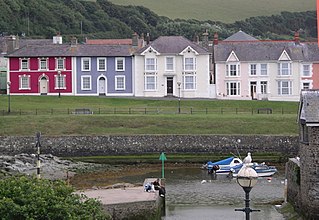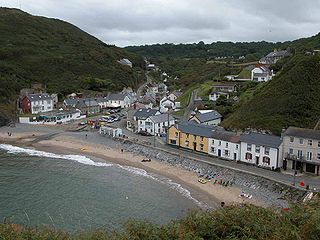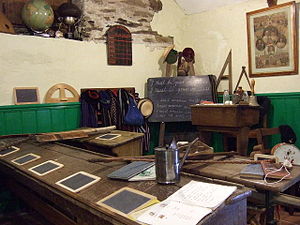
Welsh is a Celtic language of the Brittonic subgroup that is native to the Welsh people. Welsh is spoken natively in Wales, by some in England, and in Y Wladfa.

The history of what is now Wales begins with evidence of a Neanderthal presence from at least 230,000 years ago, while Homo sapiens arrived by about 31,000 BC. However, continuous habitation by modern humans dates from the period after the end of the last ice age around 9000 BC, and Wales has many remains from the Mesolithic, Neolithic, and Bronze Age. During the Iron Age the region, like all of Britain south of the Firth of Forth, the culture had become Celtic, with a common Brittonic language. The Romans, who began their conquest of Britain in AD 43, first campaigned in what is now northeast Wales in 48 against the Deceangli, and gained total control of the region with their defeat of the Ordovices in 79. The Romans departed from Britain in the 5th century, opening the door for the Anglo-Saxon settlement. Thereafter, the culture began to splinter into a number of kingdoms. The Welsh people formed with English encroachment that effectively separated them from the other surviving Brittonic-speaking peoples in the early middle ages.

Wales is a country that is part of the United Kingdom. It is bordered by the Irish Sea to the north and west, England to the east, the Bristol Channel to the south, and the Celtic Sea to the south-west. As of the 2021 census, it had a population of 3,107,494. It has a total area of 21,218 square kilometres (8,192 sq mi) and over 2,700 kilometres (1,680 mi) of coastline. It is largely mountainous with its higher peaks in the north and central areas, including Snowdon, its highest summit. The country lies within the north temperate zone and has a changeable, maritime climate. The capital and largest city is Cardiff.

The Welsh Language Society is a direct action pressure group in Wales campaigning for the right of Welsh people to use the Welsh language in every aspect of their lives. The chair of the Welsh Language Society since October 2023 is Joseff Gnagbo.

Aberaeron, previously anglicised as Aberayron, is a town, community and electoral ward in Ceredigion, Wales. Located on the coast between Aberystwyth and Cardigan, its resident population was 1,274 in the 2021 census.

Newcastle Emlyn is a town on the River Teifi, straddling the counties of Ceredigion and Carmarthenshire in West Wales. It is also a community entirely within Carmarthenshire, bordered by those of Llangeler and Cenarth, also in Carmarthenshire, and by Llandyfriog in Ceredigion. Adpar is the part of town on the Ceredigion side of the River Teifi. It was formerly called Trefhedyn and was an ancient Welsh borough in its own right. The area including Adpar had a population of 1,883 according to the 2011 census.

Tregaron is an ancient market town in Ceredigion, Wales. It is sited astride the River Brenig, a tributary of the River Teifi, and is 11 miles (18 km) north-east of Lampeter. According to the 2011 Census, the population of the ward of Tregaron was 1,213 and 67% of the population could speak Welsh; Tregaron is a community covering 33 square miles (85 km2); two-thirds of the population were born in Wales.

Llangrannog is a village and community in Ceredigion, Wales, 6 miles (10 km) southwest of New Quay. It lies in the narrow valley of the River Hawen, which falls as a waterfall near the middle of the village. Llangrannog is on the Wales Coast Path.

Llangeitho is a village and community on the upper River Aeron in Ceredigion, Wales, about four miles west of Tregaron and 11 kilometres (7 mi) north of Lampeter. Its population of 874 in 2001 fell to 819 at the 2011 census.

Aberporth is a seaside village, community and electoral ward in Ceredigion, Wales. The population at the 2001 Census, was 2,485, of whom 49 per cent could speak the Welsh language. At the 2011 Census, the population of the community was 2,374 and of the village 1241. Aberporth's beaches have earned Blue Flag status.

The Reports of the Commissioners of Inquiry into the State of Education in Wales, commonly referred to in Wales as the "Treason of the Blue Books" or "Treachery of the Blue Books" or just the "Blue Books" are a three-part publication by the British Government in 1847, which caused uproar in Wales for disparaging the Welsh; being particularly scathing in its view of the nonconformity, the Welsh language and the morality of the Welsh people in general. The Welsh sobriquet Brad y Llyfrau Gleision was from the name of a play satirising the reports, and those who gave evidence to the inquiry, which was published seven years after the reports. The Welsh Academy Encyclopaedia of Wales says that the name "took hold of the public imagination to such an extent that ever since the report has been known by that name".

Eluned Morgan, was a Welsh-language author from Patagonia. She was raised in Y Wladfa, a Welsh colony in Patagonia, and was taught to speak both Welsh and Spanish. Her father eventually enrolled her in Dr Williams' School in Wales, where she had to learn the English language. She led student protests against the school's English-only policy, which prohibited the use of Welsh by its students.

Robert Jones Derfel was a Welsh poet and political writer.
Tynged yr Iaith was a radio lecture delivered in Welsh by Saunders Lewis on 13 February 1962. Reaction to it brought about a major change in the politics of Wales. Historian John Davies has said that the lecture was "the catalyst" for the formation of Cymdeithas yr Iaith Gymraeg, and the start of a period of direct-action agitation to enhance the status of the Welsh language. Its direct effect on the formation of Cymdeithas yr Iaith Gymraeg is described in a history of that society. It has been said that "of all the memorable phrases coined in the twentieth century none has greater resonance for the Welsh speaker than Tynged yr Iaith. .. which still haunts or inspires champions of the native tongue on the cusp of the new millennium". It had the unintended effect of establishing language agitation as a movement separate from the mainstream of nationalist politics. The burgeoning effects from the initial stimulus of Tynged yr Iaith were listed by Gwyn Williams:
The history of the Welsh language spans over 1400 years, encompassing the stages of the language known as Primitive Welsh, Old Welsh, Middle Welsh, and Modern Welsh.

Aberystwyth is a university and seaside town and a community in Ceredigion, Wales. It is the largest town in Ceredigion and 16 miles (26 km) from Aberaeron, the county's administrative centre. In 2021, the population of the town was 14,640.

Dre-fach Felindre is a village in Carmarthenshire, West Wales. It is located four miles south-east of Newcastle Emlyn. It lies at the confluence of three fast-flowing streams, the Nant Bargod, Nant Esgair and Nant Brân, where their steep-sided valleys open out into the Teifi Valley. In the 19th and early 20th century it was an important centre for the woollen industry and was given the epithet, "the Huddersfield of Wales". As the population increased, the villages of Dre-fach and Felindre extended and merged to form the present community.

The modern history of Wales starts in 1800 and continues until the present day. In the 19th century, South Wales became heavily industrialised with ironworks; this, along with the spread of coal mining to the Cynon and Rhondda valleys from the 1840s, led to an increase in population. The social effects of industrialisation resulted in armed uprisings against the mainly English owners. Socialism developed in South Wales in the latter part of the century, accompanied by the increasing politicisation of religious Nonconformism. The first Labour Party MP, Keir Hardie, was elected as a junior member for the Welsh constituency of Merthyr Tydfil and Aberdare in 1900.
Nonconformity was a major religious movement in Wales from the 18th to the 20th centuries. The Welsh Methodist revival of the 18th century was one of the most significant religious and social movements in the modern history of Wales. The revival began within the Church of England in Wales, partly as a reaction to the neglect generally felt in Wales at the hands of absentee bishops and clergy. For two generations from the 1730s onwards the main Methodist leaders such as Howell Harris, Daniel Rowland and William Williams Pantycelyn remained within the Church of England, but the Welsh revival differed from the Methodist revival in England in that its theology was Calvinist rather than Arminian. Methodists in Wales gradually built up their own networks, structures, and meeting houses, which led, at the instigation of Thomas Charles, to the secession of 1811 and the formal establishment of the Calvinistic Methodist Presbyterian Church of Wales in 1823.
John Geraint Jenkins, known as J. Geraint Jenkins, was a Welsh maritime historian and historian of rural crafts.

















